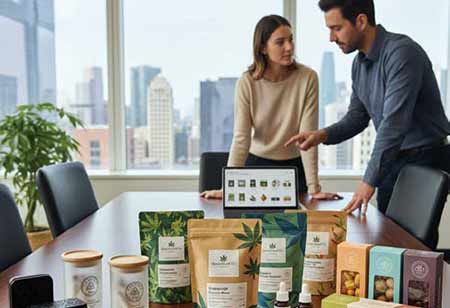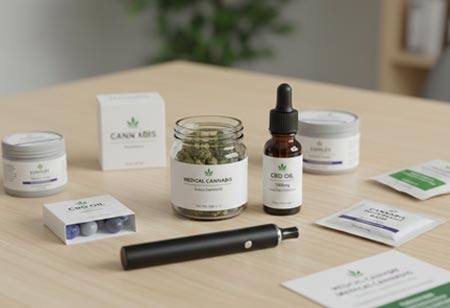Thank you for Subscribing to Cannabis Business Insights Weekly Brief
The New Role of Packaging in Cannabis Maturity
As the cannabis industry matures, packaging evolves from basic compliance to a strategic asset, enhancing consumer trust, brand identity, and product integrity through sophisticated design and technology.

By
Cannabis Business Insights | Monday, October 13, 2025
Stay ahead of the industry with exclusive feature stories on the top companies, expert insights and the latest news delivered straight to your inbox. Subscribe today.
As the global cannabis industry transitions from a nascent, fragmented market into a sophisticated mainstream sector, its operational pillars are being refined and reinforced. Once a simple afterthought driven purely by the need to contain a product and meet basic legal requirements, packaging has now emerged as a cornerstone of the industry's maturity. It is a critical strategic asset that directly influences consumer trust, brand identity, and the fundamental integrity of the product itself. In this new era, the container is as crucial as the contents, serving as the primary interface between the producer and the consumer in a landscape defined by discerning tastes and stringent regulations.
Beyond the Label: Forging Trust, Compliance, and Identity
In the early days of regulated cannabis, packaging’s primary role was to satisfy a complex patchwork of state and national laws. The focus was on the essentials: childresistant mechanisms, tamper-evident seals, and the precise placement of warning labels and potency information. While these elements remain non-negotiable foundations of consumer safety and legal compliance, the industry's perspective has broadened significantly. Today, this baseline of compliance serves as the first step in building a much more valuable commodity: consumer trust.
A professionally designed, secure package acts as a powerful visual cue. It signals to the consumer that the product within comes from a legitimate, responsible, and quality-focused operation. This subconscious assurance is paramount in an industry still working to overcome decades of stigma. The physical feel of a well-constructed box, the satisfying click of a certified closure, and the clarity of the printed information all contribute to a perception of safety and reliability before the product is ever consumed.
Beyond this foundation of trust, packaging has become the principal canvas for brand identity. As dispensary shelves become increasingly crowded, differentiation is key. The package is the brand's silent salesperson, communicating its ethos in a matter of seconds. A minimalist design with recycled materials and muted earth tones might convey a message of natural wellness and sustainability. In contrast, a sleek, dark-hued container with metallic accents and a modern font can position a product in the luxury or high-tech space. This visual language— encompassing colour theory, typography, material choice, and form factor—allows brands to connect with specific consumer archetypes, moving the conversation from a generic commodity to a curated lifestyle choice.
From Compliance to Connection: The Evolution of Consumer Engagement
The evolution of cannabis packaging mirrors the development of sophisticated consumer packaged goods, moving from a one-way communication of information to a two-way channel for consumer engagement. The package is no longer a static vessel but a dynamic touchpoint in the consumer journey, designed to educate, inform, and build a lasting relationship.
This shift is most evident in the integration of technology. Simple QR codes, once a novelty, are now a vital tool for transparency and connection. A quick scan can transport a consumer to a wealth of digital content. This often includes detailed certificates of analysis (COAs), providing third-party lab results that verify the product's potency and purity, including its cannabinoid and terpene profiles. This radical transparency is a powerful trustbuilder.
Furthermore, brands are utilizing this digital platform to share their story. Consumers can view videos of the cultivation process, learn about the brand's sustainable practices, or get detailed usage guidance and pairing suggestions. This transforms the unboxing process from a simple transaction into an immersive brand experience. The package becomes a portal, inviting the consumer to look behind the curtain and connect with the people and values driving the brand. By providing this deeper level of engagement, packaging fosters loyalty. It creates educated consumers who are more likely to become brand advocates, elevating the product from a simple purchase to a part of their personal wellness or recreational routine.
Packaging as Product Integrity: Safeguarding Potency, Freshness, and Safety
One of the most critical functions of modern cannabis packaging lies in its ability to preserve the product’s integrity. Cannabis and its derivatives are highly sensitive organic compounds that are prone to degradation when exposed to light, oxygen, moisture, or temperature fluctuations. As such, effective packaging transcends its role as a mere container—it becomes a carefully engineered microenvironment designed to safeguard the product’s chemical stability from cultivation to consumption.
The science of preservation varies across product formats. For cannabis flower, the primary threats are UV exposure, which breaks down cannabinoids, and improper humidity, which can dry out trichomes or promote mold growth. Opaque, airtight containers are essential for blocking light and preventing oxidation. Many brands incorporate two-way humidity control packs to maintain optimal moisture levels and preserve aroma, flavor, and therapeutic potency. Concentrates, such as waxes, shatters, and oils, are particularly sensitive to oxidation and material interaction, as their volatile terpenes can easily dissipate. Premium concentrate packaging often utilizes inert materials, such as glass or food-grade silicone, to prevent leaching and ensure a hermetic seal, thereby maintaining potency and flavor integrity. Edibles require dual protection—preserving freshness and ensuring precise dosing. Resealable, food-grade packaging helps prevent staleness and contamination, while individually wrapped servings or clearly marked portions promote responsible consumption. For tinctures and topicals, packaging must ensure both preservation and precision. Amber or cobalt glass bottles shield tinctures from light degradation, complemented by calibrated droppers for accurate dosing. Airless pump dispensers for topicals prevent oxidation, maintain hygiene, and provide consistent application with each use.
Ultimately, this focus on product integrity ensures that the consumer experience is consistent, safe, and effective. The packaging serves as the final guardian of quality control, guaranteeing that the investment in careful cultivation and extraction is not wasted, and that the product's promised benefits are fully delivered. As the industry continues to mature, this scientific approach to packaging will only become more vital, cementing its status as an indispensable pillar of the modern cannabis landscape.






